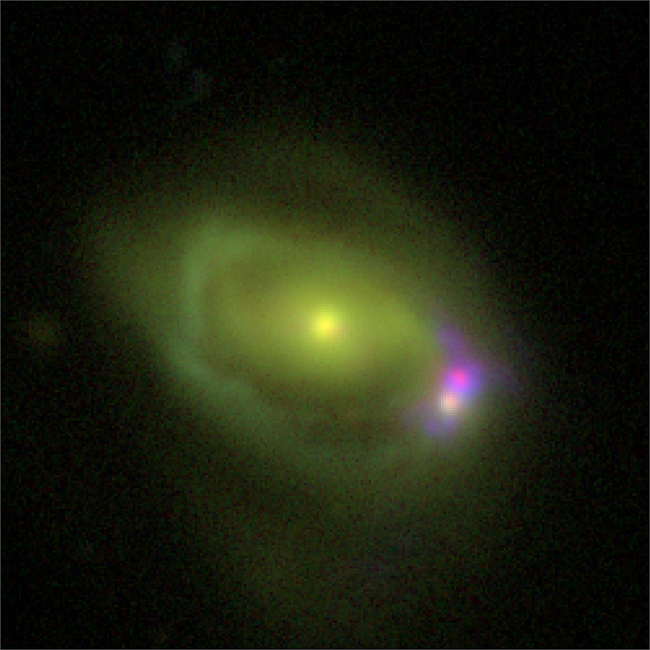
 Credit: Discovery Channel Telescope/Naval Research Laboratory
Credit: Discovery Channel Telescope/Naval Research Laboratory
A Big Hole in a Small Galaxy
Collisions between galaxies have happened throughout cosmic time. Sometimes a small fast moving galaxy may shoot through a larger, slower moving galaxy, generating beautiful ring-like structures on a galactic scale. In other cases, a larger galaxy may entirely swallow another smaller one. These mergers provide an important way in which galaxies grow and evolve. When galaxies merge, gas, dust and stars can wind up feeding the supermassive black hole at the nucleus of the larger galaxy, producing powerful X-ray radiation and strong outflows, as well as bursts of star formation near the galactic center. The image above, of a galaxy called Was 49, shows the merger of a small dwarf galaxy with a much larger disk galaxy. The dwarf galaxy can be seen as the pink and white region in the outer part of the disk of the larger galaxy, which is shown in green in the image. Both the dwarf galaxy and the disk galaxy possess their own supermassive black holes. But a new study of the X-ray emission from the dwarf galaxy, using X-ray data from the Chandra X-ray Observatory, Swift, and NuSTAR, along with optical spectroscopy, revealed a stunning surprise: the supermassive black hole in the dwarf galaxy is extremely massive, with a mass that's equivalent to the combined mass of 100 billion suns. In fact, the mass of the dwarf galaxy's supermassive black hole is a significant fraction of the mass of the entire dwarf galaxy. The dwarf's supermassive black hole also dominates the X-ray emission from Was 49, showing that it's swallowing large amounts of matter (and growing even larger). No one yet knows how such a large black hole could form in such a small galaxy.
Published: April 17, 2017
<
HEA Dictionary ● Archive
● Search HEAPOW
● Other Languages
● HEAPOW on Facebook
● Download all Images
● Education ● HEAD
>

Each week the HEASARC
brings you new, exciting and beautiful images from X-ray and Gamma ray
astronomy. Check back each week and be sure to check out the HEAPOW archive!
Page Author: Dr. Michael F. Corcoran
Last modified Monday, 26-Feb-2024 17:11:39 EST


